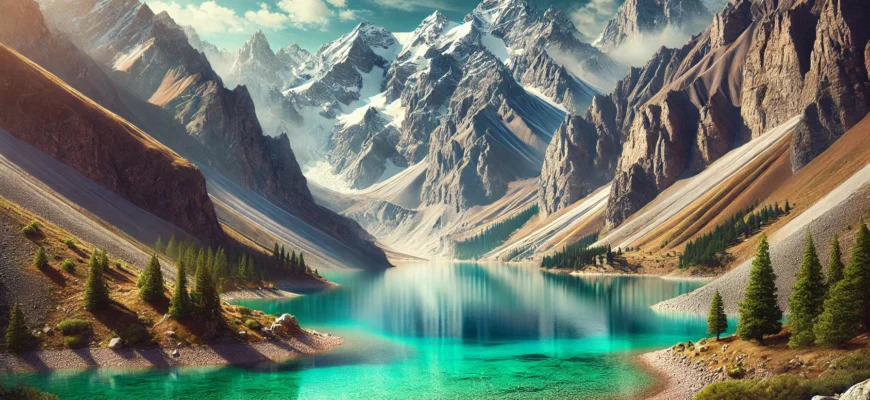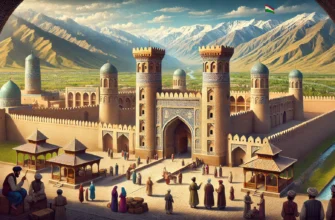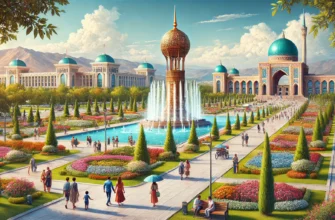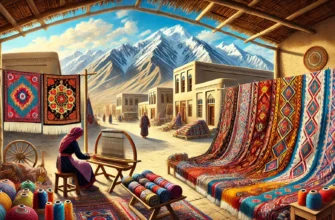Tucked away in Central Asia, Tajikistan remains a mystery to many but promises unforgettable adventures to those who venture into its landscapes. From the towering peaks of the Pamir Mountains to the tranquil allure of its deep blue lakes, Tajikistan is a land of dramatic natural beauty peppered with rich cultural histories. This nation not only boasts stunning scenery but also offers a unique glimpse into its vibrant traditions and the warm hospitality of its people.
Drawing travelers with its rugged terrains, Tajikistan is home to the famed Pamir Highway and picturesque routes like those of the Jisev Valley. Alongside towering cliffs and icy rivers, ancient remnants such as the Hissar Fortress and the ruins of Penjikent stand testament to its storied past. In the bustling heart of Dushanbe, visitors can immerse themselves in the evolving culture that embodies both history and modernity.
This article will guide you through Tajikistan’s most captivating sites, from must-visit tourist attractions to hidden gems that promise off-the-beaten-path experiences. Whether seeking natural splendor, historical depth, or cultural encounters, Tajikistan offers a kaleidoscope of adventures waiting to be explored.
Natural Attractions in Tajikistan
Tajikistan offers visitors a stunning array of natural attractions. From its towering mountains to pristine alpine lakes, the country’s landscapes are both diverse and breathtaking. Many travelers are drawn to these wild, rugged destinations to experience the true beauty of nature. Whether you are looking to explore lush valleys or hike through high-altitude terrain, Tajikistan provides endless opportunities for outdoor adventure and exploration. Let us dive into some of these extraordinary sites in this Central Asian nation.
The Majestic Pamir Highway
The Pamir Highway is a bucket-list adventure for many travelers. Known as one of the most scenic roads globally, it stretches 1,300 kilometers from Dushanbe to Osh, passing through the Pamir Mountains. This route hosts some of the tallest peaks on earth, providing stunning views around every bend. While the journey usually takes about a week, travelers experience the raw beauty and openness of Tajikistan’s southeastern and eastern regions. Throughout the trip, stops in small villages and along breathtaking viewpoints offer a deeper understanding of the area’s rich culture and history.
Stunning Vistas of the Pamir Mountains
Part of the Western Himalaya, the Pamir Mountains are often called the Roof of the World. This remote area in eastern Tajikistan is a paradise for nature lovers and thrill-seekers alike. Featuring high valleys known as pamirs, these unique landscapes are covered in lush grass and moss. The Pamirs connect with the Hindu Kush and Karakorum ranges, making them a hub of untouched natural beauty. Visitors can expect incredible scenery, perfect for a mix of adventure and cultural experiences. Whether hiking, climbing, or simply enjoying the view, the Pamir Mountains captivate all who venture there.
Serene Iskanderkul Lake
Iskanderkul Lake is a breathtaking alpine lake nestled within the Fann Mountains. Sitting at 2,200 meters above sea level, its turquoise waters span 3.4 square kilometers. The lake, named after Alexander the Great, offers a perfect spot for hiking and exploring nearby attractions such as waterfalls and smaller lakes. Located 130 kilometers north of Dushanbe, the journey to Iskanderkul is an adventure in itself, offering panoramic views along the high Anzob Pass. With opportunities for boating and hiking, Iskanderkul is a serene escape into nature’s finest creations.
Hiking Trails in the Jisev Valley
The Jisev Valley offers an authentic hiking experience for all nature enthusiasts. This trail takes adventurers through narrow paths lined with tumbling rivers and remote mountain lakes. As you walk, you’ll pass minimalistic villages, composed of just a few houses, offering a taste of traditional life. Staying overnight in Pamiri houses provides cultural insights and unforgettable memories. August hikers might enjoy finding wild cherries along the riverbanks, adding an unexpected delight to this peaceful journey. The Jisev Valley’s natural beauty captures the essence of untouched wilderness.
Exploring the Wakhan Valley
The Wakhan Valley stands as a testament to history and natural beauty. Once a pivotal hotspot between colonial powers, this valley now exudes tranquility. Visitors can explore historical sites like the 12th-century Yamchun Fortress while savoring the backdrop of breathtaking landscapes. The Bibi Khanum hot springs, known for their unique cliffside chambers, offer a soothing experience. Trekking opportunities abound, revealing traditional villages untouched by modernity. As you walk the narrow Wakhan Corridor, panoramic views extend into Afghanistan and Pakistan, providing a peek into the secluded charm of Central Asia.
Cultural and Historical Sites
Tajikistan boasts a rich tapestry of cultural and historical sites, drawing visitors to explore its past. In the northwest, Penjikent is famous for its archaeological wonders. Old Penjikent and the Sarazm site, a UNESCO World Heritage site, stand as testament to ancient civilizations. A visit to the Hissar Fortress, located 30 kilometers from Dushanbe, offers a glimpse into the 18th-century fortifications depicted on the 20 TJS banknote. The Hulbuk Fortress further reveals medieval ingenuity through its advanced sewage and water systems. Meanwhile, the capital, Dushanbe, presents a fusion of Soviet-era architecture alongside modern buildings, such as the National Museum of Tajikistan and the Presidential Palace. Together, these landmarks weave a picture of Tajikistan’s storied past and evolving present.
Dushanbe: The Vibrant Capital
Dushanbe is the bustling heart of Tajikistan, mixing history with modernity. Once a small village known for its Monday markets, it’s now a lively metropolis. The name “Dushanbe” itself means Monday in Tajiki Persian. Visitors can explore attractions like the National Museum and stroll along the tree-lined Rudaki Avenue. The city also boasts the massive Hissar Fortress and features one of the world’s tallest flagpoles. Its streets are filled with restaurants and hotels, making it easy to enjoy. With its Persian influences, Dushanbe is a welcoming place that showcases Tajikistan’s rich culture.
The Ancient Hissar Fortress
The Hissar Fortress stands as a monument to Tajikistan’s long and varied history. Located 26 kilometers from Dushanbe, it has been a key stronghold for over 2,500 years. Its roots stretch back 5,000 years, highlighting its role on the famed Silk Road. The fortress as we see today took shape in the 16th century and received restoration in the 20th century. Today, visitors walking through its ancient gates can explore its role as an open-air museum. Through its well-preserved structure, Hissar brings to life the stories and strategies of past civilizations.
Penjikent’s Ancient Ruins
Penjikent’s ancient ruins offer a striking window into the Sogdian civilization. Founded in the 5th century AD, this site was once a cultural center on the Silk Road. Surviving frescoes and artifacts reveal the vibrant life that once thrived here before the Arab invasion in the 8th century. Set on a terrace overlooking the Zerafshan River, these ruins tell tales of a thriving trade hub with artistically decorated walls. Although abandoned for centuries, the remnants of Penjikent continue to speak of Tajikistan’s rich pre-Islamic culture and its historical significance along the fabled Silk Road.
Unique Village Life and Local Culture
Tajikistan weaves a remarkable tapestry of natural beauty and cultural heritage across its diverse regions. This fascinating country offers travelers a glimpse into traditional village life, seamlessly blending historical sights with local customs. Visitors can experience unique activities like buzkashi, a celebrated horseback game, or indulge in local dishes such as qurutob and Pamiri specialties. Traditional craftsmanship thrives, especially in towns like Isfara, where artisans display stunning woodcarving skills. Tajiks are known for their warm hospitality, always welcoming outsiders and embracing cultural differences. The rich folk culture, expressed through vibrant music, dance, and handicrafts, reflects Tajikistan’s Persian and Central Asian roots.
Discovering Yagnob Valley
The Yagnob Valley is a hidden gem, often unreachable during harsh winter months. This remote region shelters a population that has preserved the ancient Sogdian language. Their isolated existence since the Arab conquest has kept their cultural and linguistic heritage intact, as if sealed away in time. While their spoken language endures, the Yagnobi people no longer use their ancient writing system. This valley’s isolation helped maintain a unique culture, offering a rare glimpse into a world somewhat removed from modern influences.
Traditions and Folk Culture
Tajikistan’s rich tradition of music and dance is captivating. Instruments like the dutor, rubab, and doyra are central to their lively performances. Visitors to Tajikistan often encounter warm hospitality, a hallmark of the Tajik people. This welcoming spirit is evident in their festivals and everyday interactions. The country also boasts a rich tradition of handicrafts, such as embroidery, carpet weaving, and pottery. Tajik culture blends ancient Persian heritage with Central Asian roots, creating a unique identity. Buzkashi, a traditional horseback game, remains a popular cultural activity, reflecting the country’s enduring connection to its past.
Adventure and Outdoor Activities
Tajikistan is a dream destination for those who love nature and adventure. It offers a range of outdoor activities in its stunning landscapes. Iskanderkul Lake is a must-see spot, located at 2,200 meters above sea level in the Fann Mountains. Named after Alexander the Great, this alpine lake is known for its scenic beauty and historical roots. Visitors can enjoy boat rides or relax by sunbathing on its beautiful beaches. For those seeking thrills, the Pamir Mountains provide countless opportunities for trekking and mountaineering. Trekking routes take you to remote villages, offering not only adventure but also authentic homestay experiences. The Anzob Pass, on the way to Iskanderkul, offers breathtaking views that enrich the journey with stunning scenery. Additionally, the Fann Mountains, with their sharp peaks, attract outdoor enthusiasts eager to explore towering terrains and natural landscapes.
Trekking Opportunities
Tajikistan is a haven for trekkers with its high-altitude trails offering breathtaking views. One popular option is the trek at Yashilkul. This three to four-day journey starts from Bachor village, presenting stunning vistas over a green lake that changes color with the seasons. The Fan Mountains provide a chance to explore snow-capped peaks, rich with alpine beauty. You can take short hiking trails around Iskanderkul in the Fan Mountains, which lead to a nearby waterfall and smaller lakes. Another must-walk route is the Pamir Highway. Known as an iconic path, it highlights the natural beauty and village life of the region. Closer to the capital city of Dushanbe, Varzob Gorge makes for a great weekend trekking spot. Here, picturesque landscapes await those keen on hiking adventures.
Interactions with Nature
The Pamirs and Fann Mountains in Tajikistan are rich with breathtaking trekking routes and offers pristine landscapes that attract nature enthusiasts. These places are known for their stunning, untouched mountain scenery. Iskanderkul Lake, with its turquoise waters, adds to the natural allure and offers activities like boat rides and beach outings. Located 130 kilometers north of Dushanbe, this beautiful lake is accessed through the scenic Anzob Pass. The Gorno-Badakhshan Autonomous Province, with diverse cultures and striking landscapes, also calls to explorers. Here, the city of Khorog acts as a central hub. Tajikistan’s terrain features peaks soaring over 7,000 meters, with more than half the country over 3,000 meters. This makes it ideal for adventure seekers and mountaineers. So if you love interacting with nature, Tajikistan’s mountains, lakes, and terrains will provide a memorable experience.
Practical Travel Information
When planning your visit to Tajikistan, it’s important to prepare in advance. Upon arrival at Dushanbe Airport, travelers from countries without a Tajik embassy can get a visa on arrival for $25. You’ll need to have filled-out forms, passport photos, and photocopies handy, along with cash. For those venturing to the remote GBAO region, an additional permit costing $50 is necessary. This can be obtained either alongside your visa or locally in Dushanbe. It’s advised to pack both warm and light clothing due to the country’s variable mountainous weather. While some ATMs are available in cities, carrying cash in the local somoni is recommended as credit cards are not widely accepted.
Best Time to Visit
Tajikistan offers diverse experiences depending on the time of year. The summer months, from June to August, present the best conditions for hiking and appreciating its natural beauty. For those interested in skiing or visiting cultural sites, winter from December to February is ideal. Outdoor enthusiasts will find trekking most enjoyable from late May to October, while the hottest months are June, July, and August, with July seeing peak temperatures. For a comfortable visit, consider planning your trip between mid-May to early June or late August to early September. This timing avoids both the extremes of summer heat and winter chills.
Transportation Tips
Traveling in Tajikistan can be challenging, so it’s essential to be aware of local conditions. The traffic culture is quite dangerous due to frequent disregard for rules and common speeding. Additionally, vehicles often lack seat belts or have ones that are not used. Roads are mostly unpaved and suitable only for off-road vehicles, particularly outside major cities like Dushanbe and Khujand. Expect longer travel times as routes meander through natural landscapes instead of direct tunnels or bridges. Traffic is often delayed by safety checkpoints, and note that turning right at a red light is not permitted unless indicated.
Accommodations in Tajikistan
When staying in Tajikistan, you’ll find a range of accommodations to suit different tastes and budgets. In the capital city, Dushanbe, options include large hotels such as the Hyatt Regency. However, these can be overpriced and in less than ideal condition, as they stem from the ex-Soviet era. Newly built hotels offer western standards, with prices ranging from $70 to $220 per room. In regions like Kalaikhum and Khorog, the Aga Khan’s Mountain Societies Development Support Programme (MSDSP) operates guesthouses offering full board for around $40 per person. In the remote Pamir region, especially near Murghab, the French NGO ACTED is setting up homestays, adding to the charm of an authentic Tajik experience. For budget travelers, guesthouses or homestays provide economical weekly rates at about $150.









